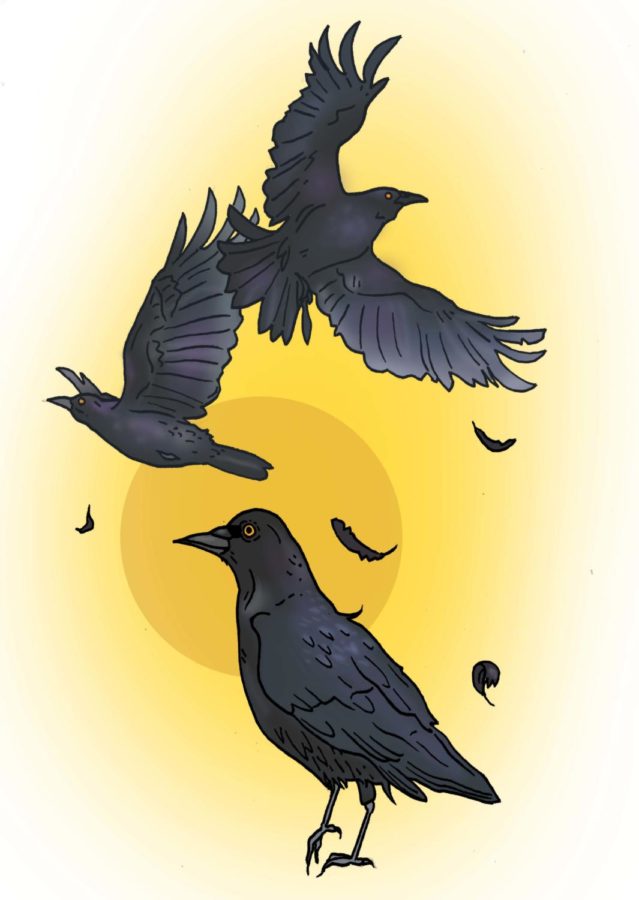Opinion | Crows on campus: Let them live their lives
November 21, 2019
Outside our windows, night falls sooner with each passing day. But the darkened skies are not just a result of the retreating sun.
Thousands of crows have taken to patrolling Pittsburgh as they migrate from the harsher Northern winter, as they have for years now, and as they have every year, many students lament over their presence on campus. But the University has already tried its hardest to exile these birds from campus grounds. It can’t and it should not do anything more that would result in their complete removal from campus. There’s plenty to appreciate about the crows.
The crows have caused some unfortunate problems for Pitt students in the past. Some students will remember slipping on their excrement and being pelted with it from above a few years ago when hundreds of the little beasts nested above the area surrounding the bus stops. Once they were nested for the season, Pitt could do little to move them and facilities workers had to routinely power-hose the mess off the sidewalks.
Despite all of that, we shouldn’t hold so much contempt for the birds. Pitt has done its best to stave off any problems by stopping the birds from nesting where they could affect students’ daily lives. Namely, the University has utilized audio recordings of distressed bird calls around the around campus at night to scare them away.
While the crows still hang around campus in mass flocks, where they nest for the winter has been pushed back to less populated areas behind buildings closer to Schenley Park like Frick Fine Arts far from where they can really bother students. Even with the successful relocation, the University remains cautious in attempting to push the birds completely off-campus for fear of where they might relocate if disturbed again.
Any additional measures the University could take to drive off the crows, besides cleaning up after them and the audio recordings, would involve shooting actual fireworks at them, which is a bit excessive. Penn State College uses “pyrotechnic bangers and screamers,” or fireworks, to scare them off. Penn State claims that the tactic is nonlethal, but even so the situation is not dire nor important enough to justify firing explosives at harmless animals. As of 2018, Pitt has no plans to use the fireworks to chase off the crows, and it should remain a line that it never crosses.
Regardless of methods, crows are also stubbornly resistant to efforts by humans to drive them out — they are are smart enough to learn when to avoid certain areas for a few hours only to return when the trouble has disappeared.
It’s unlikely the crows will ever completely leave Pitt’s campus, or the City in general. Pittsburgh just happens to be in their natural migration path, and as a species, crows prefer to return to the area where they were born every year to do their own mating. Oakland is not just a vacation spot for these birds — it is a breeding ground, and it’s partially our fault that they’re even here in the first place. Partially.
When crows and other social birds — like the infamous pigeon — started relocating to urban areas to avoid their largest natural predators like the great horned owl, they discovered all the benefits of city living and decided they did not want to leave. Researchers believe that birds now purposefully migrate and stay in cities to enjoy the added benefits of warmth, light and an abundance of resources much in the same way that humans have been moving more and more to cities for the last couple of centuries.
Pittsburgh’s rivers make the City an especially bird haven as they keep the City much warmer during the winter than out in the fields of the countryside. Oakland then becomes an ideal neighborhood to settle down in with all the lights from the University’s campus and large central streets that provide an extra boost of warmth, though experts still aren’t quite certain exactly why the birds prefer to nest in Oakland over similarly well-lit areas.
Even with their scavenging, nesting and bathroom habits, students have no need to fear the crows. They are not disease-ridden animals or an ominous sign of bad fortune or a familiar for witches or the messenger of the hooded figure of Death, contrary to popular belief. In reality, crows do not pose any direct danger to humans. At most, a person can slip on their excerment and fall into an unpleasant mess. Unless Alfred Hitchcock’s film “The Birds” comes to life from the black and white picture screen, we can learn to share the City with some real wildlife besides roaches and rats.
And at the end of the day, to be able to see such gigantic-sized roosts take to the air and swoop together amongst the neighborhood’s tallest buildings is downright majestic. As the sun sets and tints the sky to a soft pink shade, the crows become more active and take off against the clouds. It’s the small details of life that keeps it all interesting, and students should not take for granted the delightful opportunity to see a mass movement of living things besides humans or bugs.








